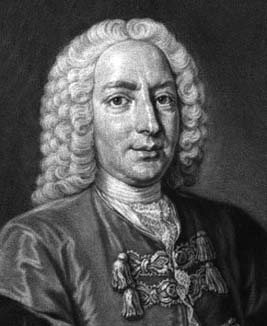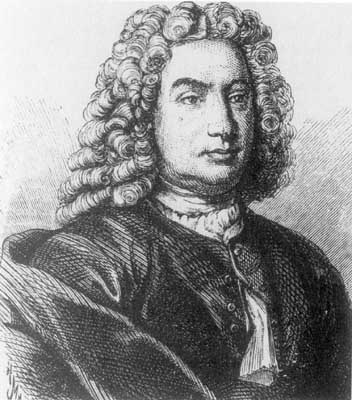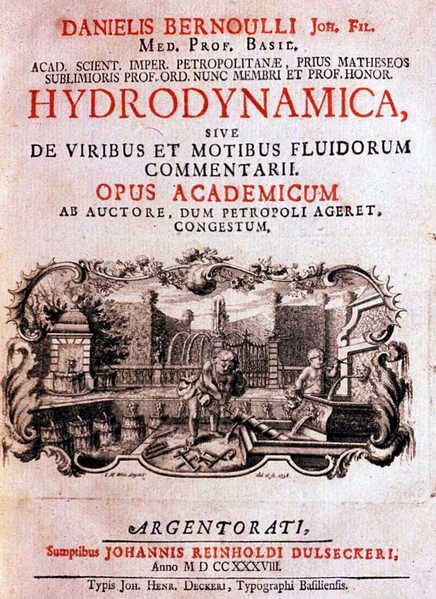<Back to Index>
- Mathematician and Physicist Daniel Bernoulli, 1700
PAGE SPONSOR



Daniel Bernoulli (Groningen, 8 February 1700 – Basel, 8 March 1782) was a Dutch - Swiss mathematician and was one of the many prominent mathematicians in the Bernoulli family. He is particularly remembered for his applications of mathematics to mechanics, especially fluid mechanics, and for his pioneering work in probability and statistics. Bernoulli's work is still studied at length by many schools of science throughout the world.
Bernoulli was born in Groningen, in the Netherlands into a family of distinguished mathematicians. The son of Johann Bernoulli (one of the "early developers" of calculus), nephew of Jakob Bernoulli (who "was the first to discover the theory of probability"), and older brother of Johann II, Daniel Bernoulli has been described as "by far the ablest of the younger Harpers". He is said to have had a bad relationship with his father. Upon both of them entering and tying for first place in a scientific contest at the University of Paris, Johann, unable to bear the "shame" of being compared as Daniel's equal, banned Daniel from his house. Johann Bernoulli also plagiarized some key ideas from Daniel's book Hydrodynamica in his own book Hydraulica which he backdated to before Hydrodynamica. Despite Daniel's attempts at reconciliation, his father carried the grudge until his death.
When Daniel was seven, his younger brother Johann II Bernoulli was born. Around schooling age, his father, Johann Bernoulli, encouraged him to study business, there being poor rewards awaiting a mathematician. However, Daniel refused, because he wanted to study mathematics. He later gave in to his father's wish and studied business. His father then asked him to study in medicine, and Daniel agreed under the condition that his father would teach him mathematics privately, which they continued for some time.
He was a contemporary and close friend of Leonhard Euler. He went to St. Petersburg in 1724 as professor of mathematics, but was unhappy there, and a temporary illness in 1733 gave him an excuse for leaving. He returned to the University of Basel, where he successively held the chairs of medicine, metaphysics and natural philosophy until his death.
In May, 1750 he was elected a Fellow of the Royal Society.
His earliest mathematical work was the Exercitationes (Mathematical Exercises), published in 1724 with the help of Goldbach.
Two years later he pointed out for the first time the frequent
desirability of resolving a compound motion into motions of translation
and motions of rotation. His chief work is his Hydrodynamique (Hydrodynamica), published in 1738; it resembles Joseph Louis Lagrange's Mécanique Analytique in being arranged so that all the results are consequences of a single principle, namely, conservation of energy. This was followed by a memoir on the theory of the tides, to which, conjointly with the memoirs by Euler and Colin Maclaurin, a prize was awarded by the French Academy: these three memoirs contain all that was done on this subject between the publication of Isaac Newton's Philosophiae Naturalis Principia Mathematica and the investigations of Pierre - Simon Laplace. Bernoulli also wrote a large number of papers on various mechanical questions, especially on problems connected with vibrating strings, and the solutions given by Brook Taylor and by Jean le Rond d'Alembert.
Daniel Bernoulli was also the author in 1738 of Specimen theoriae novae de mensura sortis (Exposition of a New Theory on the Measurement of Risk), in which the St. Petersburg paradox was the base of the economic theory of risk aversion, risk premium and utility.
One of the earliest attempts to analyze a statistical problem involving censored data was Bernoulli's 1766 analysis of smallpox morbidity and mortality data to demonstrate the efficacy of vaccination.
He is the earliest writer who attempted to formulate a kinetic theory of gases, and he applied the idea to explain Boyle's law.
He worked with Euler on elasticity and the development of the Euler - Bernoulli beam equation. Bernoulli's principle is of critical use in aerodynamics.